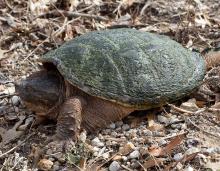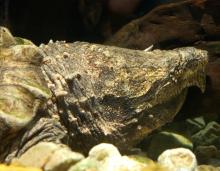Reptiles and Amphibians
Media

Species Types
Scientific Name
Terrapene ornata
Description
The ornate box turtle usually has four hind toes. Its high-domed shell is usually smooth on top, lacks a ridge, and is brown with yellow lines. Look for it in grassy habitats.
Media

Species Types
Scientific Name
Kinosternon flavescens
Description
The yellow mud turtle is a small, uniformly colored, semiaquatic turtle restricted to certain counties in west-central, northeastern, and southwestern Missouri. It is an endangered species in our state.
Media

Species Types
Scientific Name
Chrysemys dorsalis
Description
The southern painted turtle is small and has a prominent yellow, orange, or red lengthwise stripe down the middle of the upper shell. In Missouri, this aquatic turtle is found only in the Bootheel region.
Media

Species Types
Scientific Name
Plestiodon laticeps
Description
The broad-headed skink is a large, smooth-scaled lizard that lives in the southern two-thirds of Missouri. It is frequently confused with the common five-lined skink, which is smaller.
Media

Species Types
Scientific Name
Chelydra serpentina
Description
A large aquatic turtle with a big pointed head, long thick tail, and small lower shell, the eastern snapping turtle is common throughout the state, anywhere there is permanent water.
Media

Species Types
Scientific Name
Macrochelys temminckii
Description
In Missouri, alligator snapping turtles are protected, and it is illegal to harvest them. This species is totally aquatic and rarely leaves the water. In Missouri, it mainly occurs in the large rivers, sloughs, and oxbow lakes of our southern, southeastern, and eastern counties.
Media

Species Types
Scientific Name
Storeria dekayi
Description
Dekay's brownsnake is a small, secretive species that prefers moist environments. It can be gray to brown to reddish brown. It usually has a tan stripe running down the back, bordered by two rows of small brown spots. The top of the head is usually dark. Occurs statewide.
Media

Species Types
Scientific Name
Plestiodon obsoletus
Description
The Great Plains skink is a large, tan or light brown lizard with most of the scales edged in black, making it look speckled. These markings may form irregular lines along the back and sides. In Missouri, it's found only in our far western and southwestern counties.
Media

Species Types
Scientific Name
Scincella lateralis
Description
The little brown skink is a ground-dweller with dark brown or black stripes and speckling along the sides. Hiking in the woods, you may hear these small lizards scurrying through dead leaves, but you seldom see them. Occurs nearly statewide.
Media

Species Types
Scientific Name
Plestiodon septentrionalis
Description
Missouri has two subspecies of prairie skinks. They both have many stripes and a long tail. In Missouri, these lizards are rare. Northern prairie skinks occur only in our northwest counties. Southern prairie skinks are known only from Barton County, near Kansas.
See Also
About Reptiles and Amphibians in Missouri
Missouri’s herptiles comprise 43 amphibians and 75 reptiles. Amphibians, including salamanders, toads, and frogs, are vertebrate animals that spend at least part of their life cycle in water. They usually have moist skin, lack scales or claws, and are ectothermal (cold-blooded), so they do not produce their own body heat the way birds and mammals do. Reptiles, including turtles, lizards, and snakes, are also vertebrates, and most are ectothermal, but unlike amphibians, reptiles have dry skin with scales, the ones with legs have claws, and they do not have to live part of their lives in water.





















